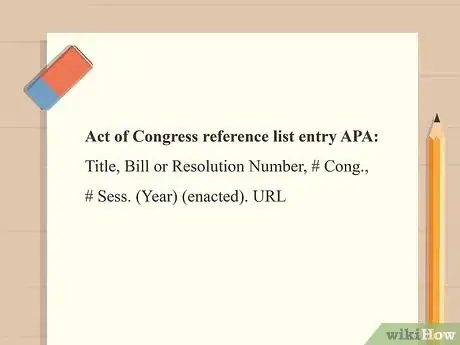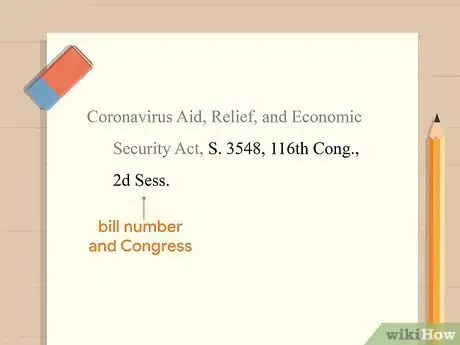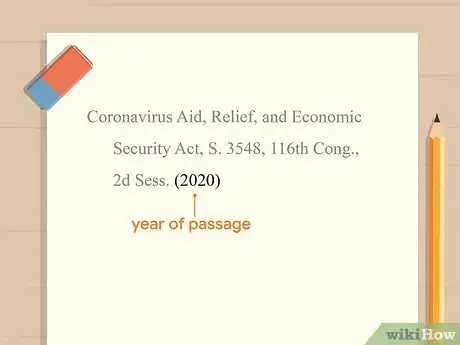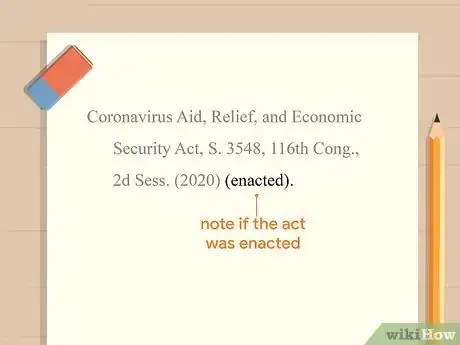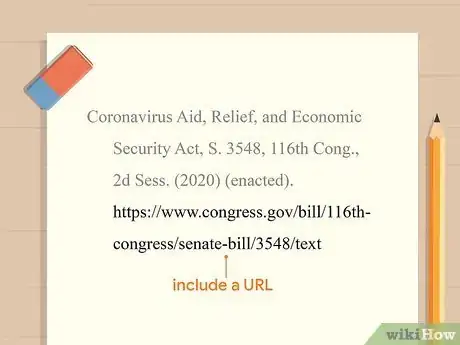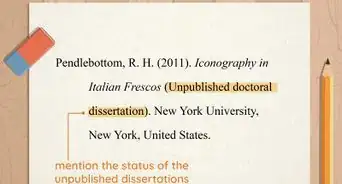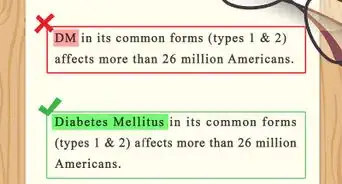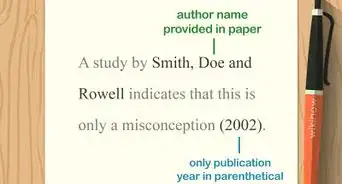This article was co-authored by wikiHow staff writer, Jennifer Mueller, JD. Jennifer Mueller is a wikiHow Content Creator. She specializes in reviewing, fact-checking, and evaluating wikiHow's content to ensure thoroughness and accuracy. Jennifer holds a JD from Indiana University Maurer School of Law in 2006.
This article has been viewed 15,735 times.
Learn more...
If you're writing a research paper, you might want to include a Congressional bill as a source. The American Psychological Association (APA) style guide refers to The Bluebook, the standard legal citation guide, for citing legal sources. This citation format differs from others you may be used to because, rather than citing directly to the source you used, you cite to the official record of the bill itself. The in-text citation is similar to those for other APA sources, except that you use the title of the act rather than the name of an author.[1]
Steps
Reference List Entry
-
1Start your Reference List entry with the title of the act. Rather than using Congress or the government as the "author" of an act of Congress, start with the title of the act. For your Reference List entry, use the official full title, capitalizing as in the original. Place a comma after the title of the act.[2]
- Example: Coronavirus Aid, Relief, and Economic Security Act,
-
2Indicate the bill number and Congress that passed the act. The bill number starts with either "H.R." (House of Representatives) or "S." (Senate). After the bill number, type a comma, then the ordinal number of Congress, using the abbreviation "Cong." Place a comma after the abbreviation period, then provide the ordinal number of the session in which the bill was passed, using the abbreviation "Sess."[3]
- Example: Coronavirus Aid, Relief, and Economic Security Act, S. 3548, 116th Cong., 2d Sess.
Advertisement -
3Provide the year of passage. After the congressional information, type the year the act was passed in parentheses. Note that if the act has a year in the title, that year might be different than the year the act was passed. The year in the title reflects the year the act was first proposed.[4]
- Example: Coronavirus Aid, Relief, and Economic Security Act, S. 3548, 116th Cong., 2d Sess. (2020)
-
4Note if the act was enacted. If the act was signed by the president and became law, type a space after the closing parenthesis for the year, then type the word "enacted" in parentheses. Place a period outside the closing parenthesis for this word. If the act wasn't enacted, simply place a period after the closing parenthesis for the year.[5]
- Example: Coronavirus Aid, Relief, and Economic Security Act, S. 3548, 116th Cong., 2d Sess. (2020) (enacted).
-
5Include a URL if one is available. Although a URL is not strictly required by the APA or The Bluebook, it can help your readers quickly locate the source. Use an official government website, not a secondary source.[6]
- Example: Coronavirus Aid, Relief, and Economic Security Act, S. 3548, 116th Cong., 2d Sess. (2020) (enacted). https://www.congress.gov/bill/116th-congress/senate-bill/3548/text
APA Reference List Format — Act of Congress
Title, Bill or Resolution Number, # Cong., # Sess. (Year) (enacted). URL
In-Text Citation
-
1Include the title of the act and the year in your parenthetical citation. A standard APA parenthetical citation lists the author and the year. Since you don't have an author for an act of Congress, use the title of the act instead. The standard parenthetical citation goes at the end of any sentence in which you paraphrase or quote from the source, inside the sentence's closing punctuation.[7]
- For example, you might write: The US Congress acted quickly to provide relief to individuals and small business owners who were struggling during the novel coronavirus pandemic (Coronavirus Aid, Relief, and Economic Security Act, 2020).
- If the act has a particularly long title, provide an abbreviation in square brackets after the title. In subsequent in-text citations, use the abbreviation rather than the full title. For example, "(Coronavirus Aid, Relief, and Economic Security Act, [CARES Act], 2020)" allows you to use "(CARES Act, 2020)" in subsequent citations.
-
2Use the popular name of the act in the text of your paper. If you want to use the title of the act in the text of your paper, use the shorter, more popular name, rather than the official name, which typically is quite lengthy and can be cumbersome to read. Your readers will be able to figure out which act you're referring to and find the official name in your Reference List.[8]
- For example, you might write: The CARES Act (2020) expands unemployment benefits to include independent contractors and gig workers who can't work due to the coronavirus outbreak.
-
3Place a parenthetical with the year after the title in your text. When you include the title of the act in your text, put the year in parentheses immediately after the title. You don't need an additional parenthetical citation at the end of the sentence.[9]
- For example, you might write: The CARES Act (2020) provides for stimulus checks to be issued to all US taxpayers.
Tip: Be careful with the year. The year of publication may be different than the year in the title of the act. When that's the case, you may want to leave off the year from the title of the act in your text to avoid confusion.
References
- ↑ https://library.delval.edu/citing-your-sources/apa#s-lg-box-17906749
- ↑ http://libanswers.walsh.edu/faq/147812
- ↑ https://libguides.bc.edu/apa7/govcite
- ↑ https://libguides.bc.edu/apa7/govcite
- ↑ https://libguides.bc.edu/apa7/govcite
- ↑ https://library.delval.edu/citing-your-sources/apa#s-lg-box-17906749
- ↑ https://libguides.bc.edu/apa7/govcite
- ↑ https://guides.library.cornell.edu/c.php?g=134360&p=881315
- ↑ https://guides.library.cornell.edu/c.php?g=134360&p=881315
